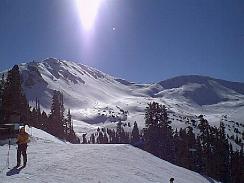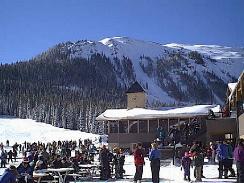Loveland
Ski Area, Colorado (2004)
![]()
Spring arrives early in the Colorado foothills in 2004, but it does so in a parched manner, as a lengthy drought has brought baking sunshine and unseasonably warm temperatures in the 70s and 80s.
I in Denver and Boulder, where I have been invited to deliver a speech about my book, Road to Ruin. I do so on a Saturday, and have a few days to kill before my return to relatively chilly Florida.
My host, friend, and former Boulder landlord generously invites me to join her for skiing at Loveland Ski Area on Monday-a place I've not skied before. In front of us are 1,265 acres of lift-served mountain slopes, and a maximum vertical drop of 2,410 feet for those of us who are addicted to the adrenalin rush of gravity.
 The sunny, warm
weather on the day we visit is melting the snow, creating crusty morning
conditions and soft, heavy snow in the afternoon. The ski slopes, we soon
learn, show evidence of drought and warmth, as we are to notice a great many
bald, rocky patches on the mountain-quite a contrast to normal conditions for
this ski area, where the average snowfall is 400 inches per year.
The sunny, warm
weather on the day we visit is melting the snow, creating crusty morning
conditions and soft, heavy snow in the afternoon. The ski slopes, we soon
learn, show evidence of drought and warmth, as we are to notice a great many
bald, rocky patches on the mountain-quite a contrast to normal conditions for
this ski area, where the average snowfall is 400 inches per year.
I arrive with trepidation. Have I not forgotten all I have learned about skiing over the past year? Do I remember how to make turns, or come to a stop? I inform my host that I will surely need to spend time on arrival out on the "bunny slopes" for beginners, since I am certain I will be a humiliating, bumbling klutz.
But we start on a "green trail," and I quickly remember what to do. At some point, skiing is like learning how to bicycle! I am surprised to learn that I have reached the point where I never forget how to negotiate the slopes.
Indeed, I soon discover one of the disappointing aspects of Loveland. The ski area has quite a few large places where there is no slope at all-often in the middle of intermediate-level slopes. Not only that, but I found that many of the "intermediate" slopes were rather pedestrian in comparison to the intermediates I have skied at Vail and Panorama. Impatiently, I start urging my companion to have us sample some black diamond trails, since I've quickly become bored by the lower-level trails.
I also notice that often, the contouring of the ski area requires the skier to laboriously ski upslope, which can be quite exhausting. We also find that the slopes frequently fail, unlike Vail and Panorama, to provide large trail maps at the chair lift entrances and exits. Furthermore, only a tiny percentage of trails are signed once the skier is on the slopes, which often requires one to guess about which direction to head to stay on the intended trail. Often, therefore, we found ourselves heading the wrong way. More than once, we unintentionally went down a black diamond that was beyond our limited skiing skills.
 By far, I find that
my favorite slope at Loveland is "Richard's Run." Very relaxing and
pleasant, without being too unchallenging. Easy place for an intermediate skier
to show off and test skills. In fact, I ski Richard's three times, and make it
my grand finale run so that I am able to leave Loveland with a pleasing taste
in my mouth.
By far, I find that
my favorite slope at Loveland is "Richard's Run." Very relaxing and
pleasant, without being too unchallenging. Easy place for an intermediate skier
to show off and test skills. In fact, I ski Richard's three times, and make it
my grand finale run so that I am able to leave Loveland with a pleasing taste
in my mouth.
My overall assessment is that while Loveland has some design and directional problems, it is relatively uncrowded and relatively affordable. And while the intermediate runs are less challenging than I prefer, the ski area seems to provide plentiful expert-level trails for the highly-skilled skier.
March 2010
Six years later, I return to Loveland, thinking it would be my first trip there because I had forgotten about the 2004 trip.
In general, my assessment remains the same. The ski resort design requires a fair amount of poling. Signs are quite frequently not available to inform the skier about trails he or she comes upon. Intermediate trails are mostly unchallenging compared to other ski resorts Iíve been to in Colorado.
I notice other things in 2010. Loveland (at least on the day I visit, if not always) does not groom black diamond trails, which mostly keeps me away from them (and mostly stuck on rather boring intermediate trails). Clocks are so few and far between (or hidden) to the extent that I found myself having to repeatedly ask chair lift staff for the time. The trail map is made with flimsy paper that is prone to quickly tearing on first use.
A significant percentage of the ski resort is above the tree line, which creates an excessively wide open, lunar-landscape-like ambience. Unlike most ski resorts Iíve been to, the ski runs I sample are so boring and unchallenging that I decide, this time, that I donít have any ďfavoriteĒ runs.
All in all, though, Loveland can provide a fairly pleasant experience, despite my observations above. On weekdays, it appears that there are so few skiers that lift lines do not exist.

Back to Dom's Voyages and Adventures page.